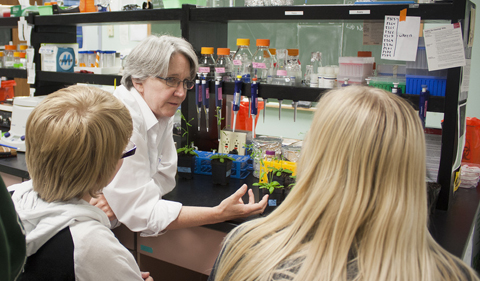Dr. Sarah Wyatt, Professor of Environmental & Plant Biology, presented “Plant gravitropic signal transduction: A network analysis leads to gene discovery” on a panel on Metabolism Related to Gravitropism at the 40th COSPAR Scientific Assembly in Moscow, Russia.
She also chaired a panel on Weightlessness and Hypergravity.
The Wyatt Lab at Ohio University uses molecular, genetic and genomic tools to study plant growth and development. Read more about Wyatt’s upcoming flight experiment on the International Space Station.
Abstract: Gravity plays a fundamental role in plant growth and development. Although a significant body of research has helped define the events of gravity perception, the role of the plant growth regulator auxin, and the mechanisms resulting in the gravity response, the events of signal transduction, those that link the biophysical action of perception to a biochemical signal that results in auxin redistribution, those that regulate the gravitropic effects on plant growth, remain, for the most part, a “black box.” Using a cold affect, dubbed the gravity persistent signal (GPS) response, we developed a mutant screen to specifically identify components of the signal transduction pathway. Cloning of the GPS genes have identified new proteins involved in gravitropic signaling. We have further exploited the GPS response using a multi-faceted approach including gene expression microarrays, proteomics analysis, and bioinformatics analysis and continued mutant analysis to identified additional genes, physiological and biochemical processes. Gene expression data provided the foundation of a regulatory network for gravitropic signaling. Based on these gene expression data and related data sets/information from the literature/repositories, we constructed a gravitropic signaling network for Arabidopsis inflorescence stems. To generate the network, both a dynamic Bayesian network approach and a time-lagged correlation coefficient approach were used. The dynamic Bayesian network added existing information of protein-protein interaction while the time-lagged correlation coefficient allowed incorporation of temporal regulation and thus could incorporate the time-course metric from the data set. Thus the methods complemented each other and provided us with a more comprehensive evaluation of connections. Each method generated a list of possible interactions associated with a statistical significance value. The two networks were then overlaid to generate a more rigorous, intersected network with shared genes and interactions. This network is flexible and can be updated with new data from the original research. The network allows identification of hubs/additional components and processes that are involved in gravitropic signal transduction to provide further hypotheses for testing. In essence, genes identified through experimental methods can be located and interactions that might connect them identified. Genes along these connections can then tested, much like stopping at towns along a driving route from one city to another.
About COSPAR: The 40th COSPAR Scientific Assembly is Aug. 2-10 in Moscow, organized by Lomonosov Moscow State University. Currently one of the most prominent scientific meetings in the world, COSPAR Scientific Assemblies were conceived to promote research in astrophysics, astronomy, space science, space biology and medicine, through free and impartial exchange of information and open discussions. Its contribution to international cooperation can hardly be overestimated, as well as its role for further enhancement of space education.



















Comments